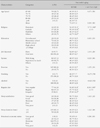Abstract
Purpose
The purpose of this study was to explore predictors of successful aging in older Korean women based on a recent mid-range nursing theory, the Successful Aging Theory (SAT).
Methods
This study utilized a descriptive correlational design. The convenience sample was composed of 174 older women living in the community. Successful aging was measured using the Successful Aging Inventory (SAI). Transcendence was measured using the Self-transcendence Scale (STS). Adaptation was measured using the Coping behavior scale. Stepwise multiple regression was used to identify significant predictors of successful aging.
Figures and Tables
References
1. Bak S.S., Kim K.S., Choi J.H. Quality of life of older women living alone: National basic livelihood act recipients. Journal of Korean Gerontological Nursing. 2010. 12(3):248–255.
2. Baltes P.B., Baltes M.M. Successful aging: Perspectives from the behavioral sciences. 1990. Cambridge: Cambridge University Press.
3. Cheng S.T., Chan A.C. Relationship with others and life satisfaction in later life: Do gender and widowhood make a difference? The Journals of Gerontology. Series B, Psychological Sciences and Social Sciences. 2006. 61(1):P46–P53.
4. Cheon J.S., Byun I.W., Song H.R., Oh B.H. Factors related to the morale of korean elderly. Journal of Korean Geriatric Psychiatry. 2004. 8:56–62.
5. Faul F., Erdfelder E., Buchner A., Lang A.R. Statistical power analyses using G*Power 3.1: Tests for correlation and regression analyses. Behavior Research Methods. 2009. 41(4):1149–1160.
6. Flood M. Successful aging: A concept analysis. Theory Construction & Testing. 2002. 6(2):105–108.
7. Flood M. A mid-range nursing theory of successful aging. Theory Construction & Testing. 2005. 9(2):35–39.
8. Flood M. Exploring the relationships between creativity, depression, and successful aging. Activities, Adaptation & Aging. 2006. 31(1):55–72.
9. Flood M., Scharer K. Creativity enhancement: Possibilities for successful aging. Issues in Mental Health Nursing. 2006. 27(9):939–959.
10. Flood M., Nies M.A., Seo D. Successful aging: Selected indicators in a southern sample. Home Health Care Management & Practice. 2010. 22(2):111–115.
11. Greenglass E., Schwarzer R., Jakubiec D., Fiksenbaum L., Taubert S. The Proactive Coping Inventory (PCI): A multidimensional research instrument. 1999. Retrieved August 2, 2011. from http://www.psych.yorku.ca/greenglass/pci.php.
12. 161th Korean woman's trend. Korean Woman's Development Institute. 2011. Retrieved October 11, 2011. from http://www.kwdi.re.kr/noticeView.kw?sgrp=S01&siteCmsCd=CM0001&topCmsCd=CM0003&cmsCd=CM0025&pnum=4&cnum=1&ntNo=1767.
13. Lee I.J. Difference between older women and older men of factors for depression and life satisfaction. Journal of Welfare for the Aged. 2007. 36:159–179.
14. McCarthy V.L. Exploring a new theory of successful aging among low-income older adults in an independent and assisted living community. 2009. Kentucky, USA: The University of Louisville;Unpublished doctoral dissertation.
15. Park J. A study on the effects of older adults' coping strategies on depression: Focused on senior centers located in Pusan, Korea. 2007. Busan: Dong-Eui University;Unpublished master's thesis.
16. Park Y.M. A comparative study on the perception of successful aging and life satisfaction between elderly men and women. 2011. Gimhae: Inje University;Unpublished Master's thesis.
17. Pfeiffer E. Short portable mental status questionnaire for the assessment of organic brain deficit in elderly patients. Journal of the American Geriatrics Society. 1975. 23:433–441.
18. Reed P.G. Self-transcendence in aging scale: Mental health of older adults. Western Journal of Nursing Research. 1989. 11(2):161–163.
19. Reed P.G.. Smith M.E., Liehr P.R, editors. Middle range theory for nursing. The theory of self-transcendence. 2003. New York: Springer;145–165.
20. Rossen E.K., Knafl K.A., Flood M. Older women's perceptions of successful aging. Activities, Adaptation & Aging. 2008. 32(2):73–88.
21. Rowe J.W., Kahn R.L. Human aging: Usual and successful. Science. 1987. 237(4811):143–149.
22. Rowe J.W., Kahn R.L. Successful aging. The Gerontologist. 1997. 37(4):433–440.
23. Roy C. Future of the Roy model: Challenge to redefine adaptation. Nursing Science Quarterly. 1997. 10(1):42–48.
24. Shin Y., Lee H. Factors associated with successful aging of Korean older people living in a city. Journal of the Korean Gerontological Society. 2009. 29(4):1327–1340.
25. Smit B., Burton I., Klein R.J.T., Street R. The science of adaptation: A framework for assessment. Mitigation & Adaption Strategies for Global Change. 1999. 4(3):199–213.
26. 2010 statistics for older adults. Statistics Korea. 2010. Retrieved September 28, 2011. from http://www.w3.org/1999/xlink" xlink:href="http://kostat.go.kr/portal/korea/kor_nw/2/1/index.board?bmode=read&aSeq=180000.
27. Sung K. Relation of successful aging and wisdom in korean older adults. Journal of Korean Gerontological Nursing. 2011. 13(1):48–57.
28. Tornstam L. Gerotranscendence: The contemplative dimension of aging. Journal of Aging Studies. 1997. 11(2):143–154.
29. 2010 census data-2010 census. U.S. Census Bureau. 2010. Retrieved September 28, 2011. from http://2010.census.gov/2010census/data/index.php.
30. Youn H., Kim M. The stress, coping behavior, and well-being of older adults. Journal of the Korea Gerontological Society. 1994. 14(1):17–32.




 PDF
PDF ePub
ePub Citation
Citation Print
Print







 XML Download
XML Download